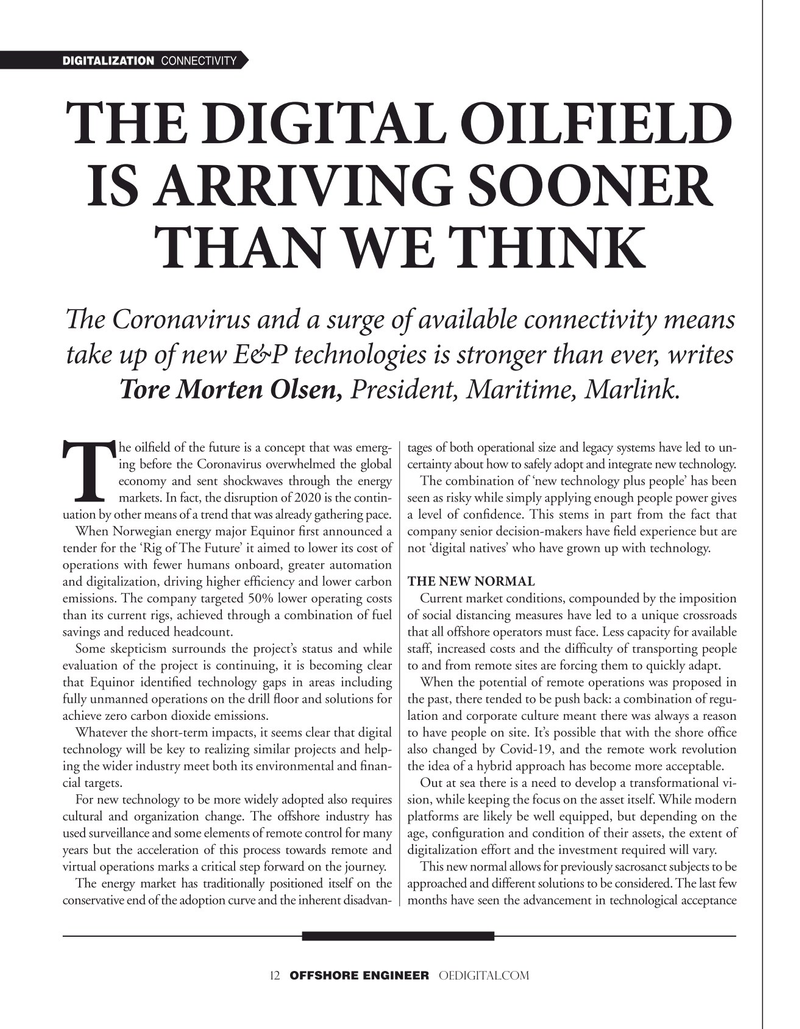
Page 12: of Offshore Engineer Magazine (Nov/Dec 2020)
Read this page in Pdf, Flash or Html5 edition of Nov/Dec 2020 Offshore Engineer Magazine
DIGITALIZATION CONNECTIVITY
THE DIGITAL OILFIELD
IS ARRIVING SOONER
THAN WE THINK
Te Coronavirus and a surge of available connectivity means take up of new E&P technologies is stronger than ever, writes
Tore Morten Olsen, President, Maritime, Marlink.
he oil?eld of the future is a concept that was emerg- tages of both operational size and legacy systems have led to un- ing before the Coronavirus overwhelmed the global certainty about how to safely adopt and integrate new technology.
economy and sent shockwaves through the energy The combination of ‘new technology plus people’ has been markets. In fact, the disruption of 2020 is the contin- seen as risky while simply applying enough people power gives
T uation by other means of a trend that was already gathering pace. a level of con?dence. This stems in part from the fact that
When Norwegian energy major Equinor ?rst announced a company senior decision-makers have ?eld experience but are tender for the ‘Rig of The Future’ it aimed to lower its cost of not ‘digital natives’ who have grown up with technology. operations with fewer humans onboard, greater automation and digitalization, driving higher ef?ciency and lower carbon THE NEW NORMAL emissions. The company targeted 50% lower operating costs Current market conditions, compounded by the imposition than its current rigs, achieved through a combination of fuel of social distancing measures have led to a unique crossroads savings and reduced headcount. that all offshore operators must face. Less capacity for available
Some skepticism surrounds the project’s status and while staff, increased costs and the dif?culty of transporting people evaluation of the project is continuing, it is becoming clear to and from remote sites are forcing them to quickly adapt. that Equinor identi?ed technology gaps in areas including When the potential of remote operations was proposed in fully unmanned operations on the drill ?oor and solutions for the past, there tended to be push back: a combination of regu- achieve zero carbon dioxide emissions. lation and corporate culture meant there was always a reason
Whatever the short-term impacts, it seems clear that digital to have people on site. It’s possible that with the shore of?ce technology will be key to realizing similar projects and help- also changed by Covid-19, and the remote work revolution ing the wider industry meet both its environmental and ?nan- the idea of a hybrid approach has become more acceptable. cial targets. Out at sea there is a need to develop a transformational vi-
For new technology to be more widely adopted also requires sion, while keeping the focus on the asset itself. While modern cultural and organization change. The offshore industry has platforms are likely be well equipped, but depending on the used surveillance and some elements of remote control for many age, con?guration and condition of their assets, the extent of years but the acceleration of this process towards remote and digitalization effort and the investment required will vary. virtual operations marks a critical step forward on the journey. This new normal allows for previously sacrosanct subjects to be
The energy market has traditionally positioned itself on the approached and different solutions to be considered. The last few conservative end of the adoption curve and the inherent disadvan- months have seen the advancement in technological acceptance 12 OFFSHORE ENGINEER OEDIGITAL.COM

 11
11

 13
13